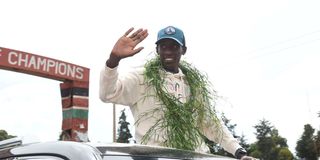Local rivalries good for growth of sport

New marathon world record holder Kelvin Kiptum waves to fans in Iten town in Elgeyo Marakwet County, on his way from Eldoret International Airport in Uasin Gishu County on October 11, 2023.
What you need to know:
- Local athletics has been abuzz, with millions baying for a Kelvin Kiptum v Eliud Kipchoge marathon duel following the former’s record-breaking run in the marathon that lasted two hours and 35 seconds in Chicago two weeks ago.
There is nothing as lovable as sporting rivalry. Boxing has produced the best match-ups which captured the imagination of the entire world, such as “Rumble in the Jungle” and “Thrilla in Manila” trilogy between Mohammad Ali and Joe Frazier, promoted by Don King.
Local athletics has been abuzz, with millions baying for a Kelvin Kiptum v Eliud Kipchoge marathon duel following the former’s record-breaking run in the marathon that lasted two hours and 35 seconds in Chicago two weeks ago.
Matters assumed an unexpected turn of events when Kipchoge failed to congratulate Kiptum. Soon, two opposing sides were outdoing each other in support of their respective athletes on social media, the favourite medium of communication for the youth.
This superficial rivalry is becoming toxic and assumes cyberbullying and character assassination on Facebook, and the conversation has evolved into what every event promoter pays millions for in advertising promotions.
This scenario is what motorsport is lacking, and losing its appeal to young people who are contended with waiting for the WRC Safari Rally once every year, far detached from rallying yet Kenya has never witnessed a generation so passionate about cars than the current one.
These Kenyans are also very knowledgeable and are willing to subscribe to TV channels which show F1, the World Rally Championship and MotoGP. They talk passionately about Max Verstappen, Lewis Hamilton, Ott Tanak, Sebastien Ogier, Mercedes, Red Bull and Ferrari like local fans of European leagues.
Why has this same enthusiasm failed to capture the imagination of young rally fans on social media? How would a conversation on who between McRae Kimathi and Jeremiah Wahome be faster, or how national champion Jasmeet Chana would fair in a shoot-out against Hamza Anwar get?
The communication skills and use of social media tools for the common good among young people in motorsport is lacking in the age group which follows international motorsports.
I recently bumped into a group of racing bikers at Garden City Mall in Nairobi during their monthly get-together where they invite experts from companies which sell those bikes and spare parts for pep talks. I asked one why they don’t engage in rallying.
His answer: “Rally fans in WhatsApp groups expend negative energy on irrelevant subjects like how the WRC Safari has killed the national championships, how locals in Naivasha are getting the short end of the stick for not getting cleaning jobs from the WRC Safari yet several billions are spent in this town.”
It is all about actionable allegations, character assassination and cyberbullying.
The youth say that they want to hear about the rivalries of Shekhar Mehta and Joginder Singh on one side, and that of Vic Preston Junior, Mike Kirkland, Rob Collinge, Jayant Shah, and Johnny Hellier on the other. Each had his own fan base, and their rivalries were fodder for the media.
Even Britain, one of the first countries to introduce motorsport, did not produce a world champion until Colin McRae broke the jinx in 1995, followed by Richard Burns. Interest in rallying reached dizzying heights in the 90s because of the superficial rivalry the world would buy.
The youth want rally fans to be more interactive and educative and talk about fast and powerful cars.
After all, they dominate the roads with souped-up standard cars and real racing machines like the odd Lamborghini, Porsches, Mercedes AMG, and Audi and Nissan GTR. Owning the Blue Subaru is no longer hip, and they show off their rides in fun events like the Masinga TT and airstrips in Kajiado, and recently in Nyahururu, leaving these small towns high and dry after they leave following their spending spree.
These youth appear more organised, some look for community-based problem solutions by visiting schools in remote places where there are less busy roads to donate foodstuff and equipment in very inspiring CRS programmes as they race.
An even more relaxed group of very young boys not yet in puberty or early teens like Munene Gitau, Cheche Ababu, Neel Gohil, Amaan Ganatra, Fahim Abdul Malik, Myles Imbayi and Ezana Gessesse who recently competed in a go-kart race in Russia, and many others are building their own sphere in autocross. They talked about motorsport.





